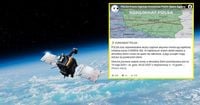In a striking turn of events, the Soviet spacecraft Kosmos 482 is set to re-enter Earth's atmosphere after more than 53 years in orbit, with its central deorbit point predicted to occur over Poland. This historic moment is slated for Saturday morning, May 10, 2025, and has captured the attention of space enthusiasts and scientists alike.
The Polish Space Agency (POLSA) has been closely monitoring Kosmos 482, which was originally launched on March 31, 1972, with the intention of studying Venus. However, due to a malfunction shortly after launch, the spacecraft has remained in Earth’s orbit since the 1980s. Experts warn that debris from the spacecraft may not completely burn up upon re-entry, raising concerns about potential impacts on the ground.
According to POLSA's latest data, the spacecraft is expected to make two flybys over Poland on May 10. The first will occur between 06:40 and 06:42 CEST, traveling from Jelenia Góra to Biała Podlaska, while the second flyby will take place from 08:11 to 08:13 CEST, moving from Zielona Góra to Lublin. The central point of deorbitation is predicted for 08:07 CEST, directly over central Poland, near Piotrków Trybunalski and Radom.
Karol Wójcicki, a science communicator and author of the popular Facebook page "Z głową w gwiazdach," has been actively sharing updates on the spacecraft’s trajectory. He emphasizes that while the spacecraft is expected to pass over Poland, the re-entry window spans approximately 13 hours, meaning the exact time and location of impact remain uncertain.
"The spacecraft's specific construction likely means it will not completely burn up before reaching Earth," Wójcicki noted. This raises the possibility that fragments of Kosmos 482 could survive the descent and reach the surface, potentially impacting populated areas.
Initially designed to withstand the harsh conditions on Venus, where temperatures can exceed 400 degrees Celsius and atmospheric pressure is about 90 times that of Earth, the robust lander weighs nearly 500 kilograms. Experts believe its strong construction may allow it to survive re-entry into Earth's atmosphere.
As the spacecraft approaches its final descent, POLSA continues to collaborate with agencies from the European Union and the United States to refine predictions regarding the timing and location of the re-entry. The dynamic nature of the spacecraft's orbit has made it challenging to provide precise estimates, but the agency is committed to keeping the public informed.
Historically, Kosmos 482's journey has been tumultuous. Following its launch, a malfunction caused the spacecraft to remain trapped in Earth’s orbit rather than proceeding to its intended destination of Venus. This failure was attributed to a timer issue that resulted in the rocket's engine shutting down prematurely. Consequently, while parts of the launch vehicle disintegrated shortly after takeoff, the lander itself has been circling the Earth for decades.
In the past, similar incidents involving spacecraft re-entries have raised public concern. For instance, in 1972, four titanium alloy spheres from a Soviet spacecraft fell near Ashburton, New Zealand, creating craters but thankfully causing no injuries. With Kosmos 482, experts warn that the situation could be similar, with the potential for debris to scatter across a wide area.
As observers await the outcome, the likelihood of Kosmos 482 landing in an unpopulated area remains a hope, given the vast expanses of ocean and uninhabited land on Earth. However, the unpredictability of space debris and the parameters of re-entry make it difficult to completely rule out the risk of impact in populated regions.
In light of these developments, POLSA has urged citizens to remain vigilant and informed about the situation. The agency has assured the public that it will continue to provide updates as new information becomes available, emphasizing the importance of monitoring the spacecraft’s trajectory as it nears Earth.
As the world watches this unfolding event, it serves as a reminder of the complexities and unpredictability of space exploration. The return of Kosmos 482 not only marks the end of a decades-long journey but also highlights the ongoing challenges faced by scientists and engineers in managing the remnants of past missions.
In conclusion, the re-entry of Kosmos 482 is a significant moment in space history, offering a unique opportunity for scientists to study the effects of atmospheric entry on a spacecraft designed for extreme conditions. Whether its fragments will safely land in the ocean or make contact with the Earth remains to be seen, but one thing is certain: the eyes of the world will be on Poland as this historic event unfolds.




